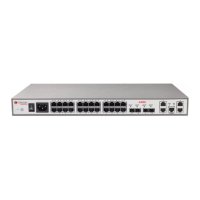A10E/A28E/A28F Configuration Guide
Figure 7-3 Principles of interface backup
As shown in Figure 7-3, Port 1 and Port 2 on Switch A are connected to their uplink devices
respectively. The interface forwarding states are shown as below:
Under normal conditions, Port 1 is the primary interface while Port 2 is the backup
interface. Port 1 and the uplink device forward packet while Port 2 and the uplink device
do not forward packets.
When the link between Port 1 and its uplink device fails, the backup Port 2 and its uplink
device forward packets.
When Port 1 restores normally and keeps Up for a period (restore-delay), Port 1 restores
to forward packets and Port 2 restores standby status.
When a switching between the primary interface and the backup interface occurs, the switch
sends a Trap to the NView NNM system.
Application of interface backup in different VLANs
By applying interface backup to different VLANs, you can enable two interfaces to share
service load in different VLANs, as shown in Figure 7-4.
Figure 7-4 Application of interface backup in different VLANs
In different VLANs, the forwarding status is shown as below:
Under normal conditions, configure Switch A in VLANs 100–150.
In VLANs 100–150, Port 1 is the primary interface and Port 2 is the backup interface.
In VLANs 151–200, Port 2 is the primary interface and Port 1 is the backup interface.
Port 1 forwards traffic of VLANs 100–150, and Port 2 forwards traffic of VLANs 151–
200.
When Port 1 fails, Port 2 forwards traffic of VLANs 100–200.
When Port 1 restores normally and keeps Up for a period (restore-delay), Port 1 forwards
traffic of VLANs 100–150, and Port 2 forwards VLANs 151–200.
Interface backup is used share service load in different VLANs without depending on
configurations of uplink switches, thus facilitating users' operation.

